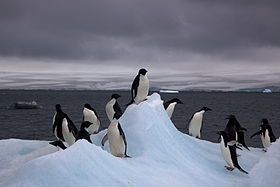Adelie Penguin
Description & Distribution...
The Adélie penguin is one of three species in the genus Pygoscelis. Adélie penguins is can usually swim at 9.0 km/h . Mitochondrial and nuclear DNA evidence suggests the genus split from other penguins around 38 million years ago about 2 million years after the ancestors of the genus Aptenodytes. In turn the Adélie penguins split off from the other members of the genus around 19 million years ago.
Habitat
Diet

The Adélie penguin is known to feed mainly on Antarctic krill, ice krill, Antarctic silverfish, sea krill and glacial squid diet varies depending on geographic location during the chick-rearing season.
Reproduction

Adélie penguins arrive at their breeding grounds in October or November, at the end of winter and the start of spring. Their nests consist of stones piled together. In December, the warmest month in Antarctica about −2 °C or 28 °F the parents take turns incubating the egg one goes to feed and the other stays to warm the egg. The Adélie penguin lives on sea ice but needs the ice-free land to breed. The parent who is incubating does not eat. In March the adults and their young return to the sea With a reduction in sea ice populations of the Adélie penguin have dropped by 65% over the past 25 years.
Migration





























0 comments:
Post a Comment